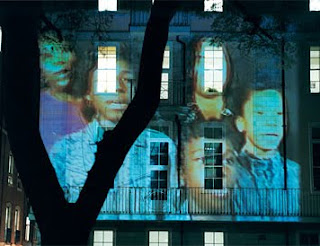 Gaze Heuristic (With Drool)
Gaze Heuristic (With Drool)
Tony Oursler was born in new york in 1957. He completed a BA in fine arts at the California Institute for the Arts, Valencia, California in 1979. His art covers a range of mediums working with video, sculpture, installation, performance and painting.
http://www.tonyoursler.com/
 Eye in the sky (1997)
Eye in the sky (1997)
A recurrent theme in Oursler's work is the way in which visual technologies influence and even modify our social and psychological selves. His practice continuously engages with popular culture and questions how systems of mechanical reproduction, like photography, film and television, have come to dictate not only the way we see the world, but also the ways that images are constructed. Ourlser's formal vocabulary is deceptively simple, employing objects of everyday life, both high and low, that range from kitsch to folk art, and investing them with a new aesthetic meaning. A key feature of his work is the ways in which the human body comes into play. On one level the body is employed in a very literal sense through the projection of fragmented and alienating body parts onto fibreglass forms. On another level the body functions through the encounter with the work. Oursler's scenarios constantly invoke the very human wish to lose oneself in fantasy.
http://www.lissongallery.com/#/artists/tony-oursler/
Tony Oursler's mixed media installations, in which theatrical objects such as puppets and dolls are layered with video projections and spoken text, are prefigured in the wildly inventive body of videotapes that he has produced over the past twenty years. In his videotapes, Oursler's idiosyncratic fictions take the form of bizarre narrative odysseys, horror-comedies. Subjective visions of cultural and psychosexual delirium are pursued with outrageous black humor and a surreal theatricality. Camera obscura (1998)
Camera obscura (1998)
Fusing media-saturated artifice with primal obsessions, the iconography of his visual tableaux ranges from the biblical to the perverse; the language of his narrated texts is hilarious, irreverent and unexpectedly poetic. Utilizing low-tech gadgets to simulate and satirize video effects, his disjunctive fictions are haunted by themes of sexual alienation and hysteria, political and cultural violence, and the dichotomies of good and evil, life and death.
 The Influence Machine
The Influence Machine
Early works, such as The Weak Bullet (1980) and Grand Mal (1981), have been described as "half Jackson Pollack, half David Cronenberg, and as funny as paranoid". The faux-naivete of his visual and spoken tales belies the textual sophistication of his meta-language of pop culture and subversion of narrative modes. Signature works have been his talking lights, such as Streetlight (1997), his series of video sculptures of eyes with television screens reflected in the pupils, and ominous talking heads such as Composite Still Life (1999). An installation called Optics (1999) examines the polarity between dark and light in the history of the camera obscura.
He also mentions the influence of artists such as Jonathan Borofsky, John Baldessari, Judy Pfaff, and Laurie Anderson. Oursler has collaborated with a number of other artists, including Constance DeJong, Joe Gibbons, Tony Conrad, and Dan Graham and the band Sonic Youth.




No comments:
Post a Comment